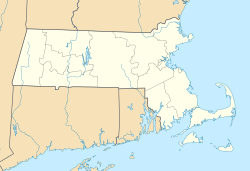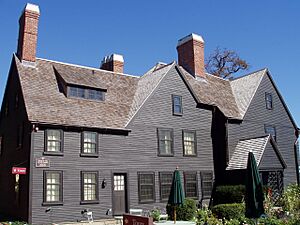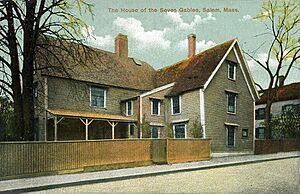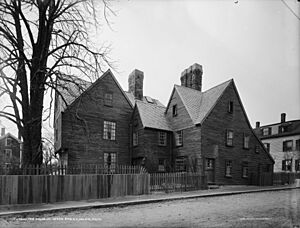House of the Seven Gables facts for kids
Quick facts for kids |
|
|
House of the Seven Gables
Historic District |
|

The House of the Seven Gables, Salem, Massachusetts. View of front and side.
|
|
| Location | Salem, Massachusetts |
|---|---|
| Built | 1668 |
| Architect | Multiple |
| Architectural style | Colonial, Georgian |
| NRHP reference No. | 73000323 |
| Added to NRHP | May 8, 1973 |
The House of the Seven Gables is a very old house in Salem, Massachusetts. It was built in 1668. This famous house gets its name from its unique roof shapes called gables. It became well-known because of Nathaniel Hawthorne's 1851 novel, The House of the Seven Gables.
Today, the house is a non-profit museum. Visitors can take tours to learn about its history. It also works as a settlement house, helping new people in the community. They offer classes like English as a Second Language (ESL) and citizenship lessons. Captain John Turner built the house, and his family lived there for three generations.
Contents
The Historic House
The first part of the House of the Seven Gables was built in 1668. It was for Captain John Turner, a rich sea captain and merchant. He was born in Salem, Massachusetts in 1644. Captain Turner used money from his trading business to help build the house. His family owned the house for three generations.
The house originally faced south towards Salem Harbor. It had two rooms and was two-and-a-half stories tall. It featured a front porch and a large chimney in the middle. This part of the house is now the middle section. Four windows from the first floor, which became a dining room, are still there.
How the House Grew
A few years later, a kitchen area was added to the back of the house. By 1676, Captain Turner built a large front addition. This new part had its own chimney. It included a living room on the first floor and a big bedroom above it. The ceilings in this new section were taller than in the older parts. This new wing had double windows and a decorative overhang. It was topped with three gables in the attic area.
In the early 1700s, John Turner II updated the house. He added new wood paneling and sash windows in the popular Georgian style. These changes are still there today. The House of the Seven Gables is one of the oldest wooden mansion houses in North America. It has 17 rooms and is over 8,000 square feet, including its large cellars.
After John Turner III lost the family's money, the Ingersoll family bought the house. They also made changes. Some gables were removed, and porches were replaced. More Georgian decorations were added.
Hawthorne's Inspiration
Nathaniel Hawthorne was a famous writer and a relative of the Ingersoll family. He visited the house often. By the time Hawthorne saw it, the house only had three gables because of earlier changes. His cousin, Susannah Ingersoll, told him stories about the house's past. She showed him old beams in the attic that showed where other gables used to be.
Hawthorne was more inspired by the sound of "seven gables" than by how the house looked at the time. He wrote in a letter that the phrase "struck me forcibly." He thought he could "make something of it." This idea led him to write his famous novel, The House of the Seven Gables.
The House in the Novel
Hawthorne wrote about the house as if it were alive. In his novel, he described it like a human face. He said it was "like a great human heart, with a life of its own." He felt it had "secrets to keep." When writing the book, Hawthorne compared it to building a real house. In January 1851, he told his publisher James T. Fields that the book was almost done. He said he was "hammering away a little on the roof." He sent the finished book to Fields by the end of that month. The House of the Seven Gables was published in April 1851.
Susanna's adopted son, Horace Ingersoll, also told Hawthorne a story about lovers from Acadia. This story later inspired Henry Wadsworth Longfellow's 1847 poem Evangeline.
The Museum Today
In 1908, Caroline Emmerton bought the house. She was the founder of the House of Seven Gables Settlement Association. She had the house restored between 1908 and 1910. Her goal was to open it as a museum. The money from museum tickets would help support her association's work.
Boston architect Joseph Everett Chandler led the restoration. He rebuilt the missing gables. Sometimes, the restoration made the house look more like Hawthorne's book than its actual history. This was done to please visitors who expected it to match the novel. For example, Emmerton added a "cent-shop" like the one in the book. A fake "Maule's Well" was also added to the garden.
She also added a hidden feature: a wood closet with a false back. When opened, it reveals a secret staircase leading to the attic.
Many original parts of the mansion are still there. These include unusual wall insulation, original beams, and beautiful Georgian wood panels.
The Nathaniel Hawthorne Birthplace is now right next to the House of the Seven Gables. You can visit it with a regular museum ticket. Even though it's where Hawthorne was born, it was moved from its original spot on Union Street.
In 1994, the Seamans Visitor Center opened at the historic site. It was named after the Seamans family, who helped with the building project.
On March 29, 2007, the House of the Seven Gables Historic District became a National Historic Landmark District. This means it's a very important historical place.
The House of the Seven Gables opened to the public in April 1910. Millions of people have visited it since then.
See also
 In Spanish: Casa de los Siete Tejados para niños
In Spanish: Casa de los Siete Tejados para niños
- List of active settlement houses
- List of historic houses in Massachusetts
- List of the oldest buildings in Massachusetts
- List of the oldest buildings in the United States
- List of National Historic Landmarks in Massachusetts
- National Register of Historic Places listings in Essex County, Massachusetts
- National Register of Historic Places listings in Salem, Massachusetts






